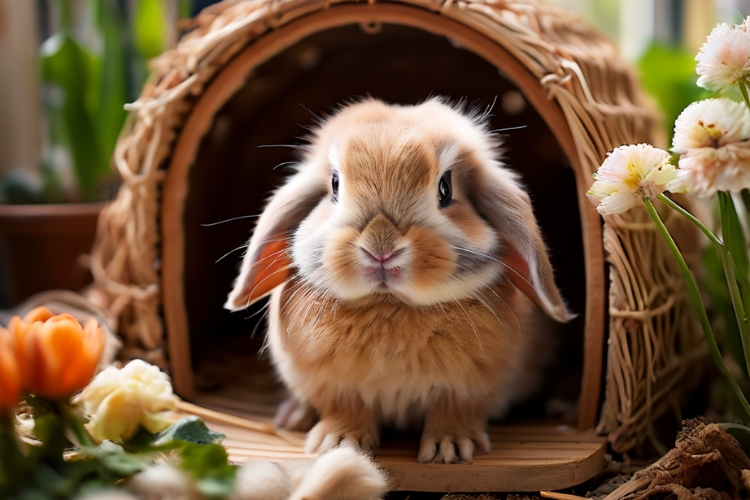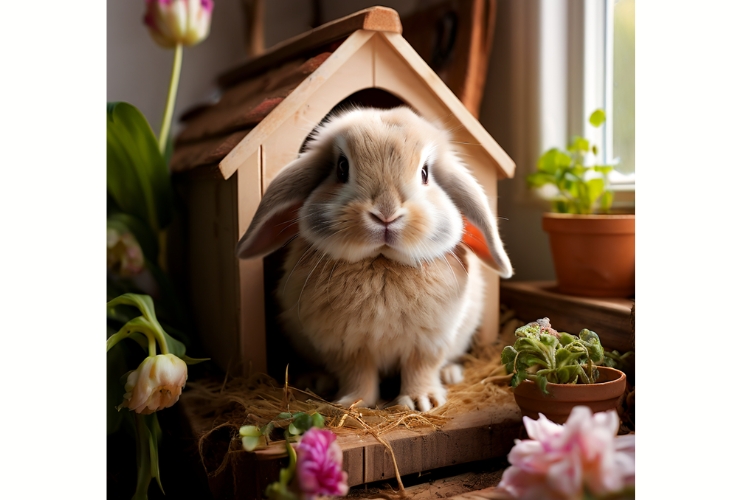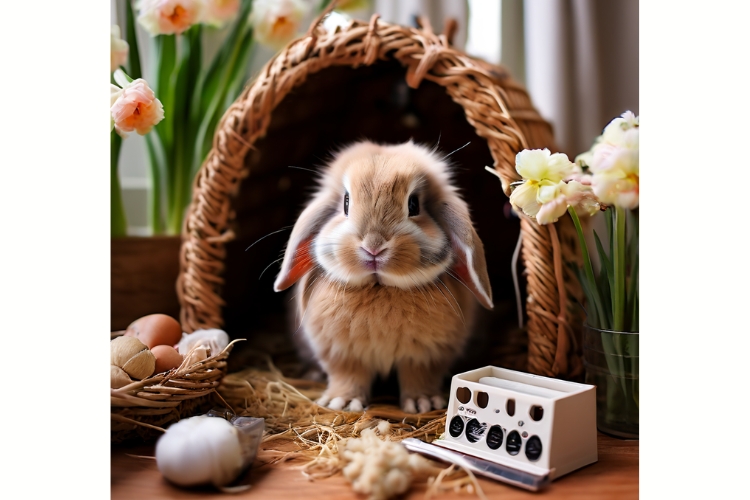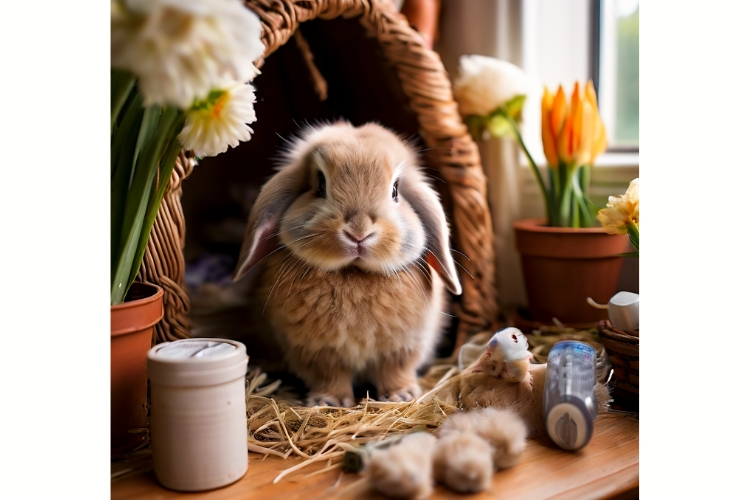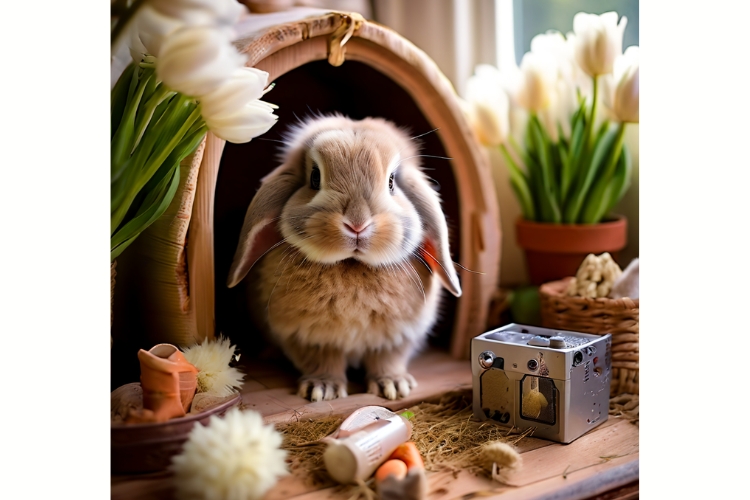As one of the most popular breeds of pet rabbits in the world, the Holland Lop deserves the very best living conditions possible.
Providing your Holland Lop bunny with appropriate housing, accessories, atmosphere, and environment is crucial for ensuring its health, happiness, and longevity as your furry companion.
In this blog post guide, we will explore key considerations and best practices for crafting the perfect Holland Lop habitat.
Housing & Cage Requirements
1. Space Requirements
The absolute minimum cage size recommended for a Holland Lop is 30” x 36”. However, bigger is always better when housing rabbits, so aim for the largest enclosure possible.
As a rule of thumb, the cage should allow enough room for the Holland Lop to take at least three consecutive hops, fully stand on its hind legs without ears touching the ceiling, and lie down fully stretched out.
2. Cage Flooring
Wire-bottomed cages may injure the Holland Lop’s sensitive feet. Instead, line the floor with straw,Carefresh paper bedding or grass hay to provide comfort and traction. Avoid wood shavings, which can cause respiratory issues when kicked up. Replace soiled bedding frequently to prevent disease.
3. Temperature, Lighting & Ventilation
Holland Lops prefer temperatures between 55-75° F degrees and cannot effectively regulate their body heat. Ensure their habitat allows for sufficient lighting during daytime hours but also provides shaded, dark areas for resting and sleeping. Proper ventilation prevents odor buildup and keeps fresh air circulating.
4. Interacting Outside the Cage
Allow the Holland Lop free exercise and interaction time outside its cage for at least an hour daily. Bunny-proof the area by removing electrical cords and toxic houseplants and monitoring for safety. Consider sectioning off a permanent Holland Lop play area using an x-pen with a slip-proof floor.
Setting Up a Play Area or Rabbit Room
1. Baby Gates & X-Pens
One of the best supplies for safely enclosing a Holland Lop play space is a tall, metal x-pen that cannot be climbed or chewed through. Attach a baby gate to the frame to cordon off a room rather than limiting play to a small area. Expand or rearrange the pen to keep things interesting.
2. Litter Box Accommodation
Holland Lops can be litter trained to relieve themselves in a designated corner of their environment. Place litter boxes with timothy hay in corners of the playpen for easy clean up.
3. Hiding Spots
Incorporate empty cardboard boxes, tunnels and willow tent hideaways into the play area so your Holland Lop has places to play hide and seek and rest in seclusion. Plastic baby keys and tunnels also make for entertaining crawling spots.
4. Environmental Enrichment
Bunnies get bored easily, so provide plenty of rotating toys for mental stimulation and activity. Good options include untreated wicker and willow balls, stacking cups, celery and carrot-scented wood chews, and sliding puzzles with treats inside. Change up accessories regularly to pique curiosity.
Important Accessories & Supplies
1. Litter & Litter Box
Line litter boxes with non-toxic litter made from recycled paper, citrus peels or pine pellets. Refill with fresh litter frequently to prevent odor buildup. Place one box in the cage plus a box per each free-roaming bunny in the pen.
2. Hay Feeder
Use a wall-mounted hay manger outside the cage to keep hay tidy. Refill with generous piles of Timothy or other grass hay for bedding and snacking. Holland Lops should have 24/7 access to hay.
3. Water Bottle & Bowl
Install 2-3 crock bowls or hanging water bottles to guarantee easy access to water at all times. Refill and scrub bowls daily. Test metal ball in bottles to ensure it isn’t stuck.
4. Food Bowl
Place a heavy ceramic food bowl on the cage floor and scatter additional pellets in a feeder outside for free access all day. This allows grazing like in nature. Wash bowl thoroughly every day.
5. Grooming Tools
Invest in a quality small animal slicker brush for daily Holland Lop coat care and occasional trimmers for nail clipping. Keep Styptic powder on hand to stop bleeding if you trim nails too short.
6. Bedding & Nesting Materials
Provide ample straw, hay and paper-based bedding materials for nesting inside hideaways and snoozing comfort. Shredded paper is optimal for burrowing and making nests cozy.
7. Chew Toys Galore
Holland Lops need diversionary chew toys made of organic materials like untreated wood, hay and wicker. Mineral chews also keep teeth healthy. Rotate semiweekly to keep it exciting.
Getting the Atmosphere Right
1. Odor & Noise Control
The ambient environment significantly impacts a Holland Lop’s mood and stress levels. Reduce unnatural noises which can frighten prey animals. Air purifiers and odor eliminators keep the atmosphere fresh-smelling and pleasant for human and bunny.
2. Lighting Schedule
Maintain the same daily cycles of light and darkness a Holland Lop would experience outdoors. Provide 11-12 hours of daylight balanced by an extended nighttime dim period for sleeping.
3. Climate Control & Circulation
Holland Lops are sensitive to temperature fluctuations beyond 55-75° F. Make sure their environment has adequate climate and ventilation controls to remain comfortable year-round. Move cages away from drafty windows or doors.
4. Music & Social Interaction
Though skittish, Holland Lops appreciate gentle classical music, talking and cuddling when they feel secure. Spend lots of quality play and petting time with yours daily. Having a bonded bunny friend also satisfies social needs.
Safety & Comfort Musts
1. Supervision is Key
When allowing your Holland Lop free range playtime, provide ample interesting stimuli but supervise continuously to prevent accidents and mischief. Never leave for extended periods – this allows risk-taking and troublemaking behavior that could lead to injury or destruction.
2. Monitor for Stress & Pain
Rabbits hide symptoms of pain and illness well in their prey animal nature. Carefully observe activity level, appetite and bathroom habits. Note signs of stress like turning away human touch, aggressiveness, hiding and/or compulsive self-grooming. Investigate any deviations from normal.
3. Emergency Preparedness
Keep basic emergency medical supplies for bunnies on hand, like Critical Care food supplements, pediatric syringes and homeopathic Gas-X drops. Program your nearest rabbit-savvy vet’s phone number into cell contacts. Post the ASPCA’s 24/7 poison helpline – (888) 426-4435 – visibly in the bunny room.
In Closing: Enjoy Your Happy Holland Lop!
Providing extensive space enriched with hideaways, toys, litter pans, feeding stations and the right substrate materials are the keys to housing Holland Lop bunnies responsibly. Select cages with plenty of room for exercising natural behaviors.
Puppy exercise pens allow safe free-range time. Observe best practices for lighting, noise regulation, climate control and emergency preparedness tailored to a rabbit’s needs. With ample attention, affection and a well-designed environment, Holland Lops make wonderfully entertaining yet docile companions for years to come!

